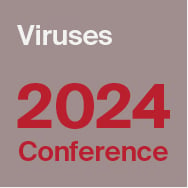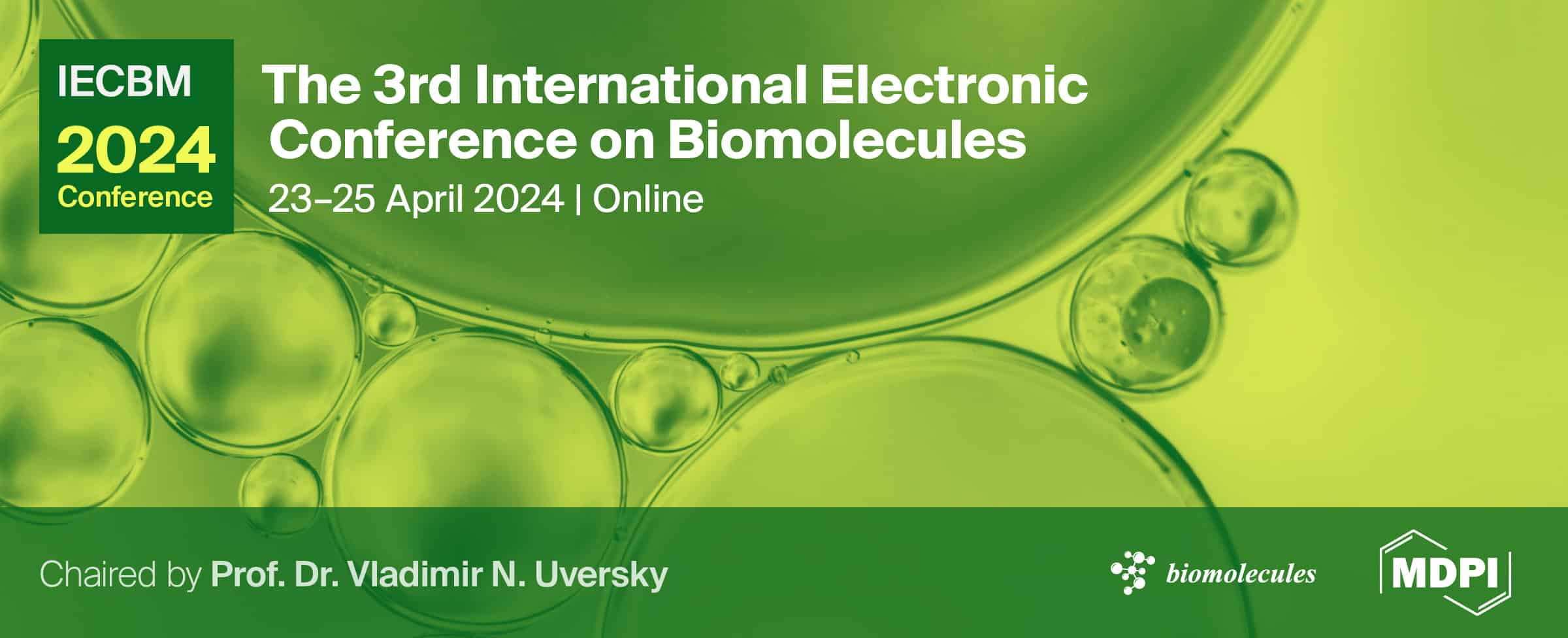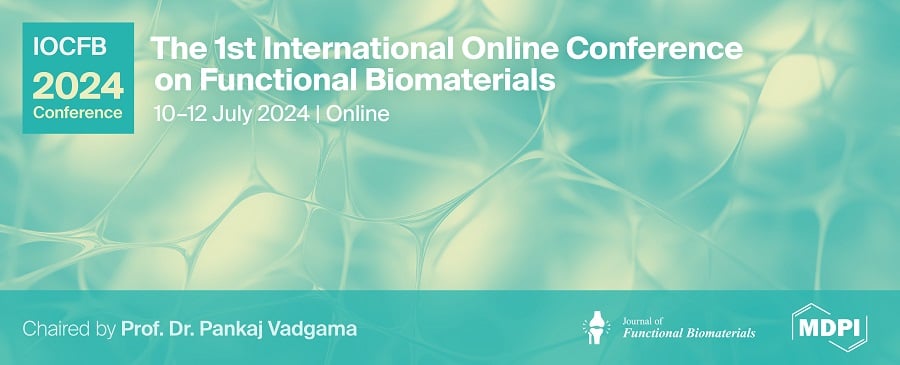Journal Description
Biomedicines
Biomedicines
is an international, peer-reviewed, open access journal on biomedicines published monthly online by MDPI. The Society for Regenerative Medicine (Russian Federation) (RPO) is affiliated with Biomedicines and its members receive discounts on the article processing charges.
- Open Access— free for readers, with article processing charges (APC) paid by authors or their institutions.
- High Visibility: indexed within Scopus, SCIE (Web of Science), PubMed, PMC, CAPlus / SciFinder, and other databases.
- Journal Rank: JCR - Q1 (Pharmacology & Pharmacy) / CiteScore - Q2 (Medicine (miscellaneous))
- Rapid Publication: manuscripts are peer-reviewed and a first decision is provided to authors approximately 15.4 days after submission; acceptance to publication is undertaken in 2.9 days (median values for papers published in this journal in the second half of 2023).
- Recognition of Reviewers: reviewers who provide timely, thorough peer-review reports receive vouchers entitling them to a discount on the APC of their next publication in any MDPI journal, in appreciation of the work done.
- Companion journals for Biomedicines include: IJTM, BioMed, Anesthesia Research and Emergency Care and Medicine.
Impact Factor:
4.7 (2022);
5-Year Impact Factor:
4.9 (2022)
Latest Articles
Transforming Growth Factor Beta 2 (TGFB2) and Interferon Gamma Receptor 2 (IFNGR2) mRNA Levels in the Brainstem Tumor Microenvironment (TME) Significantly Impact Overall Survival in Pediatric DMG Patients
Biomedicines 2024, 12(1), 191; https://doi.org/10.3390/biomedicines12010191 - 15 Jan 2024
Abstract
This hypothesis-generating study characterized the mRNA expression profiles and prognostic impacts of antigen-presenting cell (APC) markers (CD14, CD163, CD86, and ITGAX/CD11c) in pediatric brainstem diffuse midline glioma (pbDMG) tumors. We also assessed the mRNA levels of two therapeutic targets, transforming growth factor beta
[...] Read more.
This hypothesis-generating study characterized the mRNA expression profiles and prognostic impacts of antigen-presenting cell (APC) markers (CD14, CD163, CD86, and ITGAX/CD11c) in pediatric brainstem diffuse midline glioma (pbDMG) tumors. We also assessed the mRNA levels of two therapeutic targets, transforming growth factor beta 2 (TGFB2) and interferon gamma receptor 2 (IFNGR2), for their biomarker potentials in these highly aggressive pbDMG tumors. The expressions of CD14, CD163, and ITGAX/CD11c mRNAs exhibited significant decreases of 1.64-fold (p = 0.037), 1.75-fold (p = 0.019), and 3.33-fold (p < 0.0001), respectively, in pbDMG tumors relative to those in normal brainstem/pons samples. The pbDMG samples with high levels of TGFB2 in combination with low levels of APC markers, reflecting the cold immune state of pbDMG tumors, exhibited significantly worse overall survival outcomes at low expression levels of CD14, CD163, and CD86. The expression levels of IFNGR2 and TGFB2 (1.51-fold increase (p = 0.002) and 1.58-fold increase (p = 5.5 × 10−4), respectively) were significantly upregulated in pbDMG tumors compared with normal brainstem/pons samples. We performed multivariate Cox proportional hazards modelling that showed TGFB2 was a prognostic indicator (HR for patients in the TGFB2high group of pbDMG patients = 2.88 (1.12–7.39); p = 0.028) for poor overall survival (OS) and was independent of IFNGR2 levels, the age of the patient, and the significant interaction effect observed between IFNGR2 and TGFB2 (p = 0.015). Worse survival outcomes in pbDMG patients when comparing high versus low TGFB2 levels in the context of low IFNGR2 levels suggest that the abrogation of the TGFB2 mRNA expression in the immunologically cold tumor microenvironment can be used to treat pbDMG patients. Furthermore, pbDMG patients with low levels of JAK1 or STAT1 mRNA expression in combination with high levels of TGFB2 also exhibited poor OS outcomes, suggesting that the inclusion of (interferon-gamma) IFN-γ to stimulate and activate JAK1 and STAT1 in anti-tumor APC cells present the brainstem TME can enhance the effect of the TGFB2 blockade.
Full article
(This article belongs to the Special Issue Gliomas: Signaling Pathways, Molecular Mechanisms and Therapeutic Approaches)
Open AccessArticle
Circulating Lipoprotein Sphingolipids in Chronic Kidney Disease with and without Diabetes
Biomedicines 2024, 12(1), 190; https://doi.org/10.3390/biomedicines12010190 - 15 Jan 2024
Abstract
Abnormalities of sphingolipid metabolism play an important role in diabetes. We compared sphingolipid levels in plasma and in isolated lipoproteins between healthy control subjects and two groups of patients, one with chronic kidney disease without diabetes (ND-CKD), and the other with type 2
[...] Read more.
Abnormalities of sphingolipid metabolism play an important role in diabetes. We compared sphingolipid levels in plasma and in isolated lipoproteins between healthy control subjects and two groups of patients, one with chronic kidney disease without diabetes (ND-CKD), and the other with type 2 diabetes and macroalbuminuria (D-MA). Ceramides, sphingomyelins, and sphingoid bases and their phosphates in LDL were higher in ND-CKD and in D-MA patients compared to controls. However, ceramides and sphingoid bases in HDL2 and HDL3 were lower in ND-CKD and in D-MA patients than in controls. Sphingomyelins in HDL2 and HDL3 were lower in D-MA patients than in controls but were normal in ND-CKD patients. Compared to controls, lactosylceramides in LDL and VLDL were higher in ND-CKD patients but not in D-MA patients. However, lactosylceramides in HDL2 and HDL3 were lower in both ND-CKD and D-MA patients than in controls. Plasma hexosylceramides in ND-CKD patients were increased and sphingoid bases decreased in both ND-CKD and D-MA patients. However, hexosylceramides in LDL, HDL2, and HDL3 were higher in ND-CKD patients than in controls. In D-MA patients, only C16:0 hexosylceramide in LDL was higher than in controls. The data suggest that sphingolipid measurement in lipoproteins, rather than in whole plasma, is crucial to decipher the role of sphingolipids in kidney disease.
Full article
(This article belongs to the Special Issue New Advances in Chronic Kidney Disease: Biology, Diagnosis and Therapy)
►▼
Show Figures
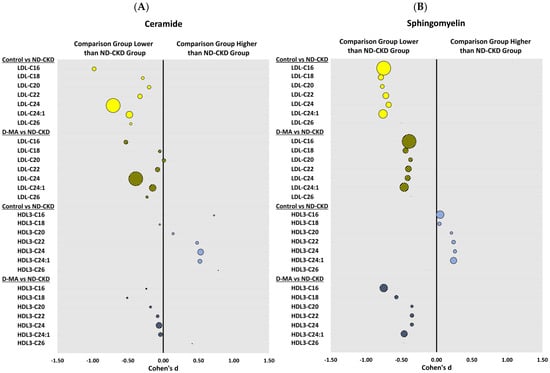
Figure 1
Open AccessArticle
Cannabinerol (CBNR) Influences Synaptic Genes Associated with Cytoskeleton and Ion Channels in NSC-34 Cell Line: A Transcriptomic Study
by
, , , , and
Biomedicines 2024, 12(1), 189; https://doi.org/10.3390/biomedicines12010189 - 15 Jan 2024
Abstract
Cannabinoids are receiving great attention as a novel approach in the treatment of cognitive and motor disabilities, which characterize neurological disorders. To date, over 100 phytocannabinoids have been extracted from Cannabis sativa, and some of them have shown neuroprotective properties and the
[...] Read more.
Cannabinoids are receiving great attention as a novel approach in the treatment of cognitive and motor disabilities, which characterize neurological disorders. To date, over 100 phytocannabinoids have been extracted from Cannabis sativa, and some of them have shown neuroprotective properties and the capacity to influence synaptic transmission. In this study, we investigated the effects of a less-known phytocannabinoid, cannabinerol (CBNR), on neuronal physiology. Using the NSC-34 motor-neuron-like cell line and next-generation sequencing analysis, we discovered that CBNR influences synaptic genes associated with synapse organization and specialization, including genes related to the cytoskeleton and ion channels. Specifically, the calcium, sodium, and potassium channel subunits (Cacna1b, Cacna1c, Cacnb1, Grin1, Scn8a, Kcnc1, Kcnj9) were upregulated, along with genes related to NMDAR (Agap3, Syngap1) and calcium (Cabp1, Camkv) signaling. Moreover, cytoskeletal and cytoskeleton-associated genes (Actn2, Ina, Trio, Marcks, Bsn, Rtn4, Dgkz, Htt) were also regulated by CBNR. These findings highlight the important role played by CBNR in the regulation of synaptogenesis and synaptic transmission, suggesting the need for further studies to evaluate the neuroprotective role of CBNR in the treatment of synaptic dysfunctions that characterize motor disabilities in many neurological disorders.
Full article
(This article belongs to the Special Issue Therapeutic Potential for Cannabis and Cannabinoids 2.0)
Open AccessArticle
The Traumatic Inoculation Process Affects TSPO Radioligand Uptake in Experimental Orthotopic Glioblastoma
by
, , , , , , , , , , , , , , , , , , , , , , , and add
Show full author list
remove
Hide full author list
Biomedicines 2024, 12(1), 188; https://doi.org/10.3390/biomedicines12010188 - 15 Jan 2024
Abstract
Background: The translocator protein (TSPO) has been proven to have great potential as a target for the positron emission tomography (PET) imaging of glioblastoma. However, there is an ongoing debate about the potential various sources of the TSPO PET signal. This work investigates
[...] Read more.
Background: The translocator protein (TSPO) has been proven to have great potential as a target for the positron emission tomography (PET) imaging of glioblastoma. However, there is an ongoing debate about the potential various sources of the TSPO PET signal. This work investigates the impact of the inoculation-driven immune response on the PET signal in experimental orthotopic glioblastoma. Methods: Serial [18F]GE-180 and O-(2-[18F]fluoroethyl)-L-tyrosine ([18F]FET) PET scans were performed at day 7/8 and day 14/15 after the inoculation of GL261 mouse glioblastoma cells (n = 24) or saline (sham, n = 6) into the right striatum of immunocompetent C57BL/6 mice. An additional n = 25 sham mice underwent [18F]GE-180 PET and/or autoradiography (ARG) at days 7, 14, 21, 28, 35, 50 and 90 in order to monitor potential reactive processes that were solely related to the inoculation procedure. In vivo imaging results were directly compared to tissue-based analyses including ARG and immunohistochemistry. Results: We found that the inoculation process represents an immunogenic event, which significantly contributes to TSPO radioligand uptake. [18F]GE-180 uptake in GL261-bearing mice surpassed [18F]FET uptake both in the extent and the intensity, e.g., mean target-to-background ratio (TBRmean) in PET at day 7/8: 1.22 for [18F]GE-180 vs. 1.04 for [18F]FET, p < 0.001. Sham mice showed increased [18F]GE-180 uptake at the inoculation channel, which, however, continuously decreased over time (e.g., TBRmean in PET: 1.20 at day 7 vs. 1.09 at day 35, p = 0.04). At the inoculation channel, the percentage of TSPO/IBA1 co-staining decreased, whereas TSPO/GFAP (glial fibrillary acidic protein) co-staining increased over time (p < 0.001). Conclusion: We identify the inoculation-driven immune response to be a relevant contributor to the PET signal and add a new aspect to consider for planning PET imaging studies in orthotopic glioblastoma models.
Full article
(This article belongs to the Special Issue State of the Art and Future Perspectives in Oncologic Imaging)
►▼
Show Figures

Figure 1
Open AccessReview
Aptamer-Based Smart Targeting and Spatial Trigger–Response Drug-Delivery Systems for Anticancer Therapy
Biomedicines 2024, 12(1), 187; https://doi.org/10.3390/biomedicines12010187 - 15 Jan 2024
Abstract
In recent years, the field of drug delivery has witnessed remarkable progress, driven by the quest for more effective and precise therapeutic interventions. Among the myriad strategies employed, the integration of aptamers as targeting moieties and stimuli-responsive systems has emerged as a promising
[...] Read more.
In recent years, the field of drug delivery has witnessed remarkable progress, driven by the quest for more effective and precise therapeutic interventions. Among the myriad strategies employed, the integration of aptamers as targeting moieties and stimuli-responsive systems has emerged as a promising avenue, particularly in the context of anticancer therapy. This review explores cutting-edge advancements in targeted drug-delivery systems, focusing on the integration of aptamers and stimuli-responsive platforms for enhanced spatial anticancer therapy. In the aptamer-based drug-delivery systems, we delve into the versatile applications of aptamers, examining their conjugation with gold, silica, and carbon materials. The synergistic interplay between aptamers and these materials is discussed, emphasizing their potential in achieving precise and targeted drug delivery. Additionally, we explore stimuli-responsive drug-delivery systems with an emphasis on spatial anticancer therapy. Tumor microenvironment-responsive nanoparticles are elucidated, and their capacity to exploit the dynamic conditions within cancerous tissues for controlled drug release is detailed. External stimuli-responsive strategies, including ultrasound-mediated, photo-responsive, and magnetic-guided drug-delivery systems, are examined for their role in achieving synergistic anticancer effects. This review integrates diverse approaches in the quest for precision medicine, showcasing the potential of aptamers and stimuli-responsive systems to revolutionize drug-delivery strategies for enhanced anticancer therapy.
Full article
(This article belongs to the Special Issue Feature Reviews in Anticancer Drug Delivery Systems)
►▼
Show Figures

Figure 1
Open AccessArticle
Endocyclophotocoagulation Combined with Phacoemulsification in Glaucoma Treatment: Five-Year Results
Biomedicines 2024, 12(1), 186; https://doi.org/10.3390/biomedicines12010186 - 15 Jan 2024
Abstract
Background: this study aimed to assess the effectiveness and safety of phaco-endocyclophotocoagulation (phaco-ECP) in patients with glaucoma over five consecutive years. Methods: Thirty-eight patients (38 eyes) with primary and secondary glaucoma were enrolled to undergo phaco-ECP (Endo Optiks URAM E2, Beaver-Visitec International, Waltham,
[...] Read more.
Background: this study aimed to assess the effectiveness and safety of phaco-endocyclophotocoagulation (phaco-ECP) in patients with glaucoma over five consecutive years. Methods: Thirty-eight patients (38 eyes) with primary and secondary glaucoma were enrolled to undergo phaco-ECP (Endo Optiks URAM E2, Beaver-Visitec International, Waltham, MA, USA). The primary outcome measures were intraocular pressure (IOP) reduction, success rates, glaucoma medication use, and visual acuity after phaco-ECP. An IOP reduction of 20% compared to the baseline value without re-intervention was considered a successful treatment. Complete success was defined as a cessation of antiglaucoma medications. Secondary outcome measures included intraoperative and postoperative complications. Measurements were performed preoperatively and in the first week and 1, 3, 6, 12, 18, 24, 30, 36, 42, 48, 54, and 60 months postoperatively. Results: The mean ± SD values of IOP preoperatively, at 12, 24, 36, 48, and 60 months postoperatively were 22.6 ± 6.7 mmHg, 15.9 ± 3.9 mmHg (p < 0.001), 15.9 ± 2.9 mmHg (p < 0.001), 15.6 ± 2.7 mmHg (p < 0.001), 15.5 ± 3.8 mmHg (p < 0.001), and 15.2 ± 2.6 mmHg (p < 0.001), respectively. The mean IOP at the last follow-up was reduced by 32.7%. The decrease in the number of antiglaucoma medications was statistically significant at each follow-up visit compared to the baseline. The qualified success rate was 40.6%. All patients at the 60-month follow-up visit required the use of antiglaucoma medications—none of the patients achieved complete success. During the follow-up period, nine patients (28.3%) that required retreatment due to nonachievement of the target IOP were considered failures. Six patients (15.8%) were lost from the follow-up. A total of 23 patients were evaluated 60 months after their phaco-ECP. Complications directly associated with the procedure, such as corneal edema (25.6%), IOP spikes (20.5%), IOL dislocation (2.6%), and uveitis (12.8%), were observed in our patients. Hypotony was not observed in any of our patients. Conclusions: The phaco-ECP procedure was effective, well-tolerated, and safe for reducing IOP in glaucoma patients with cataracts over a long-term follow-up. Randomized, larger-scale studies are required to validate the results obtained.
Full article
(This article belongs to the Special Issue Glaucoma: New Diagnostic and Therapeutic Approaches)
►▼
Show Figures
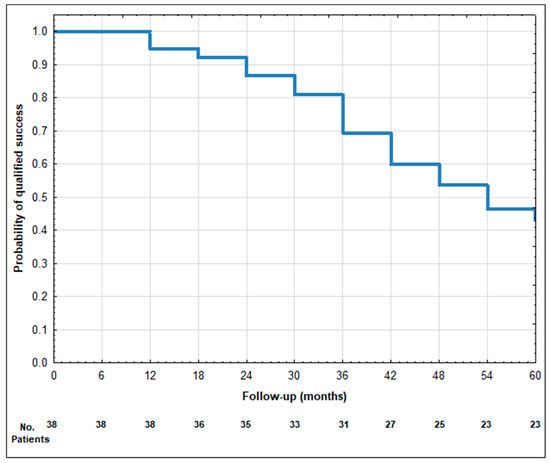
Figure 1
Open AccessReview
Nanotechnology Innovations in Pediatric Cardiology and Cardiovascular Medicine: A Comprehensive Review
by
, , , , , , , , , and
Biomedicines 2024, 12(1), 185; https://doi.org/10.3390/biomedicines12010185 - 15 Jan 2024
Abstract
(1) Background: Nanomedicine, incorporating various nanoparticles and nanomaterials, offers significant potential in medical practice. Its clinical adoption, however, faces challenges like safety concerns, regulatory hurdles, and biocompatibility issues. Despite these, recent advancements have led to the approval of many nanotechnology-based products, including those
[...] Read more.
(1) Background: Nanomedicine, incorporating various nanoparticles and nanomaterials, offers significant potential in medical practice. Its clinical adoption, however, faces challenges like safety concerns, regulatory hurdles, and biocompatibility issues. Despite these, recent advancements have led to the approval of many nanotechnology-based products, including those for pediatric use. (2) Methods: Our approach included reviewing clinical, preclinical, and animal studies, as well as literature reviews from the past two decades and ongoing trials. (3) Results: Nanotechnology has introduced innovative solutions in cardiovascular care, particularly in managing myocardial ischemia. Key developments include drug-eluting stents, nitric oxide-releasing coatings, and the use of magnetic nanoparticles in cardiomyocyte transplantation. These advancements are pivotal for early detection and treatment. In cardiovascular imaging, nanotechnology enables noninvasive assessments. In pediatric cardiology, it holds promise in assisting the development of biological conduits, synthetic valves, and bioartificial grafts for congenital heart defects, and offers new treatments for conditions like dilated cardiomyopathy and pulmonary hypertension. (4) Conclusions: Nanomedicine presents groundbreaking solutions for cardiovascular diseases in both adults and children. It has the potential to transform cardiac care, from enhancing myocardial ischemia treatment and imaging techniques to addressing congenital heart issues. Further research and guideline development are crucial for optimizing its clinical application and revolutionizing patient care.
Full article
(This article belongs to the Special Issue State-of-the-Art Nanomedicine and Nanobiotechnology in Europe)
►▼
Show Figures
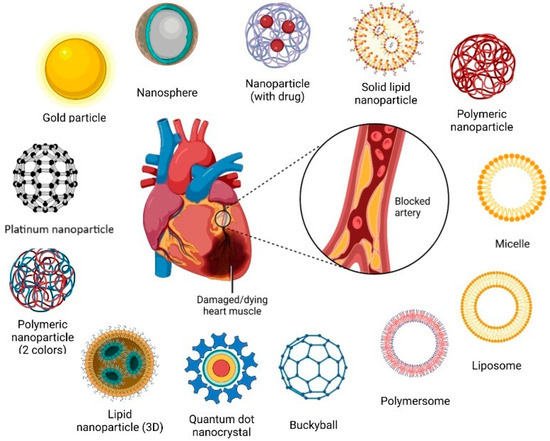
Figure 1
Open AccessReview
Menopause-Associated Depression: Impact of Oxidative Stress and Neuroinflammation on the Central Nervous System—A Review
by
, , , , and
Biomedicines 2024, 12(1), 184; https://doi.org/10.3390/biomedicines12010184 - 15 Jan 2024
Abstract
Perimenopausal depression, occurring shortly before or after menopause, is characterized by symptoms such as emotional depression, anxiety, and stress, often accompanied by endocrine dysfunction, particularly hypogonadism and senescence. Current treatments for perimenopausal depression primarily provide symptomatic relief but often come with undesirable side
[...] Read more.
Perimenopausal depression, occurring shortly before or after menopause, is characterized by symptoms such as emotional depression, anxiety, and stress, often accompanied by endocrine dysfunction, particularly hypogonadism and senescence. Current treatments for perimenopausal depression primarily provide symptomatic relief but often come with undesirable side effects. The development of agents targeting the specific pathologies of perimenopausal depression has been relatively slow. The erratic fluctuations in estrogen and progesterone levels during the perimenopausal stage expose women to the risk of developing perimenopausal-associated depression. These hormonal changes trigger the production of proinflammatory mediators and induce oxidative stress, leading to progressive neuronal damage. This review serves as a comprehensive overview of the underlying mechanisms contributing to perimenopausal depression. It aims to shed light on the complex relationship between perimenopausal hormones, neurotransmitters, brain-derived neurotrophic factors, chronic inflammation, oxidative stress, and perimenopausal depression. By summarizing the intricate interplay between hormonal fluctuations, neurotransmitter activity, brain-derived neurotrophic factors, chronic inflammation, oxidative stress, and perimenopausal depression, this review aims to stimulate further research in this field. The hope is that an increased understanding of these mechanisms will pave the way for the development of more effective therapeutic targets, ultimately reducing the risk of depression during the menopausal stage for the betterment of psychological wellbeing.
Full article
(This article belongs to the Special Issue Molecular Insights into Depression)
►▼
Show Figures

Figure 1
Open AccessReview
Overcoming Chemotherapy Resistance in Metastatic Cancer: A Comprehensive Review
Biomedicines 2024, 12(1), 183; https://doi.org/10.3390/biomedicines12010183 - 15 Jan 2024
Abstract
The management of metastatic cancer is complicated by chemotherapy resistance. This manuscript provides a comprehensive academic review of strategies to overcome chemotherapy resistance in metastatic cancer. The manuscript presents background information on chemotherapy resistance in metastatic cancer cells, highlighting its clinical significance and
[...] Read more.
The management of metastatic cancer is complicated by chemotherapy resistance. This manuscript provides a comprehensive academic review of strategies to overcome chemotherapy resistance in metastatic cancer. The manuscript presents background information on chemotherapy resistance in metastatic cancer cells, highlighting its clinical significance and the current challenges associated with using chemotherapy to treat metastatic cancer. The manuscript delves into the molecular mechanisms underlying chemotherapy resistance in subsequent sections. It discusses the genetic alterations, mutations, and epigenetic modifications that contribute to the development of resistance. Additionally, the role of altered drug metabolism and efflux mechanisms, as well as the activation of survival pathways and evasion of cell death, are explored in detail. The strategies to overcome chemotherapy resistance are thoroughly examined, covering various approaches that have shown promise. These include combination therapy approaches, targeted therapies, immunotherapeutic strategies, and the repurposing of existing drugs. Each strategy is discussed in terms of its rationale and potential effectiveness. Strategies for early detection and monitoring of chemotherapy drug resistance, rational drug design vis-a-vis personalized medicine approaches, the role of predictive biomarkers in guiding treatment decisions, and the importance of lifestyle modifications and supportive therapies in improving treatment outcomes are discussed. Lastly, the manuscript outlines the clinical implications of the discussed strategies. It provides insights into ongoing clinical trials and emerging therapies that address chemotherapy resistance in metastatic cancer cells. The manuscript also explores the challenges and opportunities in translating laboratory findings into clinical practice and identifies potential future directions and novel therapeutic avenues. This comprehensive review provides a detailed analysis of strategies to overcome chemotherapy resistance in metastatic cancer. It emphasizes the importance of understanding the molecular mechanisms underlying resistance and presents a range of approaches for addressing this critical issue in treating metastatic cancer.
Full article
(This article belongs to the Special Issue Feature Reviews in Anticancer Drug Delivery Systems)
Open AccessArticle
The Relationship between Time, Race, and Estrogen Receptor Alpha in Estradiol-Induced Dermal Fibrosis
Biomedicines 2024, 12(1), 182; https://doi.org/10.3390/biomedicines12010182 - 15 Jan 2024
Abstract
In the skin, estradiol (E2) promotes profibrotic and proinflammatory cytokines, contributing to extracellular matrix (ECM) deposition. However, the magnitude of the response differs. Using the human skin organ culture model, we evaluated donor characteristics and correlations that contribute to E2-induced interleukin-6 (IL-6
[...] Read more.
In the skin, estradiol (E2) promotes profibrotic and proinflammatory cytokines, contributing to extracellular matrix (ECM) deposition. However, the magnitude of the response differs. Using the human skin organ culture model, we evaluated donor characteristics and correlations that contribute to E2-induced interleukin-6 (IL-6), transforming growth factor beta 1 and 2 (TGFB1 and TGFB2), collagen IA2 (Col IA2), collagen IIIA1 (Col IIIA1), and fibronectin (FN) expressions. In vehicle- and E2-treated dermal skin tissue transcripts, we confirm differences in the magnitude; however, there were positive correlations between profibrotic mediators and ECM components 48 h after E2 treatment. Also, positive correlations exist between baseline and E2-induced TGFB1, IL-6, Col IIIA1, and FN transcripts. Since estrogen receptor alpha (ERA) can propagate E2′s signal, we measured and detected differences in its baseline and fold change transcript levels, with a significant decline in baseline levels 48 h after incubation and an increase 48 h after E2 treatment. There was a trend to higher transcript levels in African American donors 24 h earlier. Finally, E2-induced ERA transcript levels negatively correlated with its own baseline levels and positively correlated with FN, TGFB1, and Col IA2 transcript levels. Therefore, our data suggest ERA, E2 exposure time, and race/ethnicity contribute to E2-induced dermal fibrosis.
Full article
(This article belongs to the Special Issue Skin Fibrosis and Cutaneous Wound Healing)
►▼
Show Figures
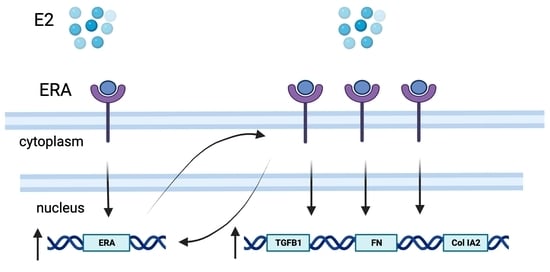
Graphical abstract
Open AccessArticle
Therapeutic Potential of Bipolar Androgen Therapy for Castration-Resistant Prostate Cancer: In Vitro and In Vivo Studies
Biomedicines 2024, 12(1), 181; https://doi.org/10.3390/biomedicines12010181 - 15 Jan 2024
Abstract
Androgen deprivation therapy (ADT) is a primary treatment for advanced prostate cancer (PCa), but resistance often leads to castration-resistant PCa (CRPC). CRPC remains androgen receptor (AR)-dependent, and AR overexpression causes vulnerability to high doses of androgen in CRPC. Bipolar androgen therapy (BAT) refers
[...] Read more.
Androgen deprivation therapy (ADT) is a primary treatment for advanced prostate cancer (PCa), but resistance often leads to castration-resistant PCa (CRPC). CRPC remains androgen receptor (AR)-dependent, and AR overexpression causes vulnerability to high doses of androgen in CRPC. Bipolar androgen therapy (BAT) refers to the periodic administration of testosterone, resulting in oscillation between supraphysiologic and near-castrate serum testosterone levels. In this study, we evaluated the efficacy of BAT against CRPC in a preclinical setting. To emulate CRPC characteristics, PCa cell lines (LNCaP, VCaP, and 22Rv1) were cultured in phenol red-free RPMI-1640 medium supplemented with 10% dextran-coated charcoal treated FBS (A− cell line). Cell viability, AR, and AR-V7 expression were evaluated using the Cell Counting Kit-8 and Western blotting. In vivo studies involved 12 castrated NOG mice injected with LNCaP/A− cells, treated with testosterone pellets or controls in 2-week cycles. Tumor sizes were measured post a 6-week treatment cycle. Bicalutamide inhibited PCa cell viability but not in the adapted cell lines. Supraphysiologic androgen levels suppressed AR-expressing PCa cell growth in vitro. In vivo, high AR-expressing LNCaP cells proliferated under castrate conditions, while BAT-treated xenografts exhibited significant growth inhibition with low Ki-67 and mitotic indexes and a high cell death index. This study provides preliminary evidence that BAT is effective for the treatment of CRPC through rapid cycling between supraphysiologic and near-castrate serum testosterone levels, inducing an anti-tumor effect.
Full article
(This article belongs to the Special Issue Novel Strategy for Treating Castration-Resistant Prostate Cancer (Volume II))
►▼
Show Figures

Figure 1
Open AccessArticle
Optimization of a Photobiomodulation Protocol to Improve the Cell Viability, Proliferation and Protein Expression in Osteoblasts and Periodontal Ligament Fibroblasts for Accelerated Orthodontic Treatment
by
, , , , , , , , and
Biomedicines 2024, 12(1), 180; https://doi.org/10.3390/biomedicines12010180 - 14 Jan 2024
Abstract
Numerous pieces of evidence have supported the therapeutic potential of photobiomodulation (PBM) to modulate bone remodeling on mechanically stimulated teeth, proving PBM’s ability to be used as a coadjuvant treatment to accelerate orthodontic tooth movement (OTM). However, there are still uncertainty and discourse
[...] Read more.
Numerous pieces of evidence have supported the therapeutic potential of photobiomodulation (PBM) to modulate bone remodeling on mechanically stimulated teeth, proving PBM’s ability to be used as a coadjuvant treatment to accelerate orthodontic tooth movement (OTM). However, there are still uncertainty and discourse around the optimal PBM protocols, which hampers its optimal and consolidated clinical applicability. Given the differential expression and metabolic patterns exhibited in the tension and compression sides of orthodontically stressed teeth, it is plausible that different types of irradiation may be applied to each side of the teeth. In this sense, this study aimed to design and implement an optimization protocol to find the most appropriate PBM parameters to stimulate specific bone turnover processes. To this end, three levels of wavelength (655, 810 and 940 nm), two power densities (5 and 10 mW/cm2) and two regimens of single and multiple sessions within three consecutive days were tested. The biological response of osteoblasts and periodontal ligament (PDL) fibroblasts was addressed by monitoring the PBM’s impact on the cellular metabolic activity, as well as on key bone remodeling mediators, including alkaline phosphatase (ALP), osteoprotegerin (OPG) and receptor activator of nuclear factor κ-B ligand (RANK-L), each day. The results suggest that daily irradiation of 655 nm delivered at 10 mW/cm2, as well as 810 and 940 nm light at 5 mW/cm2, lead to an increase in ALP and OPG, potentiating bone formation. In addition, irradiation of 810 nm at 5 mW/cm2 delivered for two consecutive days and suspended by the third day promotes a downregulation of OPG expression and a slight non-significant increase in RANK-L expression, being suitable to stimulate bone resorption. Future studies in animal models may clarify the impact of PBM on bone formation and resorption mediators for longer periods and address the possibility of testing different stimulation periodicities. The present in vitro study offers valuable insights into the effectiveness of specific PBM protocols to promote osteogenic and osteoclastogenesis responses and therefore its potential to stimulate bone formation on the tension side and bone resorption on the compression side of orthodontically stressed teeth.
Full article
(This article belongs to the Topic Medical and Dental Care, Photobiomodulation and Photomedicine)
►▼
Show Figures

Figure 1
Open AccessCase Report
Takotsubo Syndrome during Pertuzumab and Trastuzumab Therapy for HER2-Positive Metastatic Breast Cancer
by
, , , , , and
Biomedicines 2024, 12(1), 179; https://doi.org/10.3390/biomedicines12010179 - 14 Jan 2024
Abstract
Pertuzumab and trastuzumab have been shown to improve the outcomes of patients with metastatic breast cancer, with a rate of left ventricular dysfunction of approximately 6%. We report the case of a postmenopausal woman who presented with Takotsubo syndrome during maintenance therapy with
[...] Read more.
Pertuzumab and trastuzumab have been shown to improve the outcomes of patients with metastatic breast cancer, with a rate of left ventricular dysfunction of approximately 6%. We report the case of a postmenopausal woman who presented with Takotsubo syndrome during maintenance therapy with pertuzumab and trastuzumab, in association with fulvestrant (an anti-estrogen) and denosumab. After normalization of cardiac function, therapy with pertuzumab and trastuzumab was resumed in the absence of new cardiac toxicity. We report the first clinical case of Takotsubo syndrome during double anti-HER2 blockade in association with an antiestrogen. Furthermore, we show how anti-HER2 therapy can be safely resumed after the detection of Takotsubo syndrome.
Full article
(This article belongs to the Special Issue New Insights into Breast Cancer Management: From Tumorigenesis to Personalized Treatments)
►▼
Show Figures
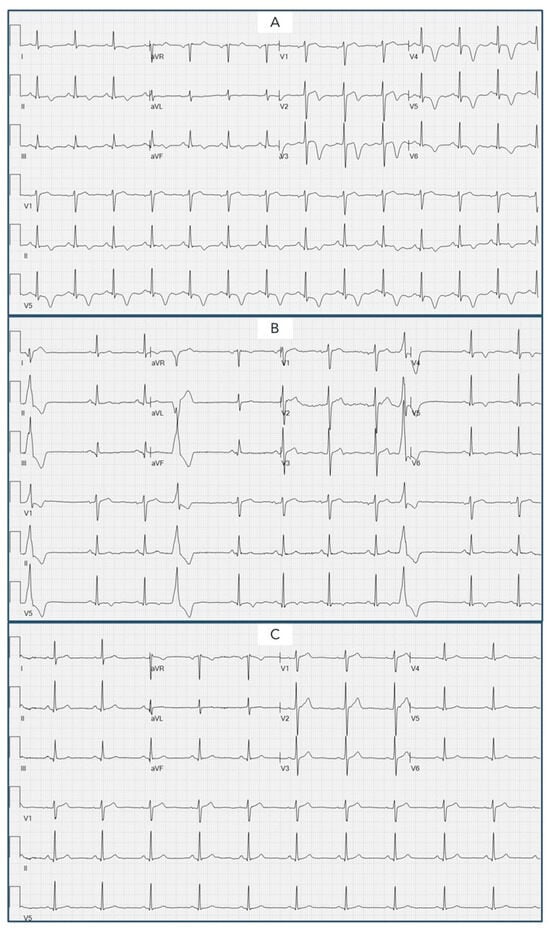
Figure 1
Open AccessReview
The Beneficial Role of Apigenin against Cognitive and Neurobehavioural Dysfunction: A Systematic Review of Preclinical Investigations
Biomedicines 2024, 12(1), 178; https://doi.org/10.3390/biomedicines12010178 - 13 Jan 2024
Abstract
Apigenin is a flavone widely present in different fruits and vegetables and has been suggested to possess neuroprotective effects against some neurological disorders. In this study, we systematically reviewed preclinical studies that investigated the effects of apigenin on learning and memory, locomotion activity,
[...] Read more.
Apigenin is a flavone widely present in different fruits and vegetables and has been suggested to possess neuroprotective effects against some neurological disorders. In this study, we systematically reviewed preclinical studies that investigated the effects of apigenin on learning and memory, locomotion activity, anxiety-like behaviour, depressive-like behaviour and sensorimotor and motor coordination in rats and mice with impaired memory and behaviour. We searched SCOPUS, Web of Science, PubMed and Google Scholar for relevant articles. A total of 34 studies were included in this review. The included studies revealed that apigenin enhanced learning and memory and locomotion activity, exhibited anxiolytic effects, attenuated depressive-like behaviour and improved sensorimotor and motor coordination in animals with cognitive impairment and neurobehavioural deficit. Some of the molecular and biochemical mechanisms of apigenin include activation of the ERK/CREB/BDNF signalling pathway; modulation of neurotransmitter levels and monoaminergic, cholinergic, dopaminergic and serotonergic systems; inhibition of pro-inflammatory cytokine production; and attenuation of oxidative neuronal damage. These results revealed the necessity for further research using established doses and short or long durations to ascertain effective and safe doses of apigenin. These results also point to the need for a clinical experiment to ascertain the therapeutic effect of apigenin.
Full article
(This article belongs to the Special Issue Neurodegeneration in Cognitive Impairment and Mood Disorders for Experimental, Clinical and Translational Neuropsychiatry)
►▼
Show Figures

Figure 1
Open AccessReview
Sarcoidosis Associated Pulmonary Hypertension
Biomedicines 2024, 12(1), 177; https://doi.org/10.3390/biomedicines12010177 - 13 Jan 2024
Abstract
In patients with sarcoidosis, the development of pulmonary hypertension is associated with significant morbidity and mortality. The global prevalence of sarcoidosis-associated pulmonary hypertension (SAPH) reportedly ranges between 2.9% and 20% of sarcoidosis patients. Multiple factors may contribute to the development of SAPH, including
[...] Read more.
In patients with sarcoidosis, the development of pulmonary hypertension is associated with significant morbidity and mortality. The global prevalence of sarcoidosis-associated pulmonary hypertension (SAPH) reportedly ranges between 2.9% and 20% of sarcoidosis patients. Multiple factors may contribute to the development of SAPH, including advanced parenchymal lung disease, severe systolic and/or diastolic left ventricular dysfunction, veno-occlusive or thromboembolic disease, as well as extrinsic factors such as pulmonary vascular compression from enlarged lymph nodes, anemia, and liver disease. Early diagnosis of SAPH is important but rarely achieved primarily due to insufficiently accurate screening strategies, which rely entirely on non-invasive tests and clinical assessment. The definitive diagnosis of SAPH requires right heart catheterization (RHC), with transthoracic echocardiography as the recommended gatekeeper to RHC according to current guidelines. A 6-min walk test (6MWT) had the greatest prognostic value in SAPH patients based on recent registry outcomes, while advanced lung disease determined using a reduced DLCO (<35% predicted) was associated with reduced transplant-free survival in pre-capillary SAPH. Clinical management involves the identification and treatment of the underlying mechanism. Pulmonary vasodilators are useful in several scenarios, especially when a pulmonary vascular phenotype predominates. End-stage SAPH may warrant consideration for lung transplantation, which remains a high-risk option. Multi-centered randomized controlled trials are required to develop existing therapies further and improve the prognosis of SAPH patients.
Full article
(This article belongs to the Special Issue The Impact of Comorbidities on Sarcoidosis)
►▼
Show Figures
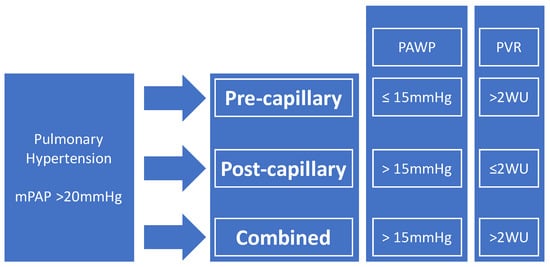
Figure 1
Open AccessReview
Innovative Biomedical and Technological Strategies for the Control of Bacterial Growth and Infections
by
, , , and
Biomedicines 2024, 12(1), 176; https://doi.org/10.3390/biomedicines12010176 - 13 Jan 2024
Abstract
Antibiotics comprise one of the most successful groups of pharmaceutical products. Still, they have been associated with developing bacterial resistance, which has become one of the most severe problems threatening human health today. This context has prompted the development of new antibiotics or
[...] Read more.
Antibiotics comprise one of the most successful groups of pharmaceutical products. Still, they have been associated with developing bacterial resistance, which has become one of the most severe problems threatening human health today. This context has prompted the development of new antibiotics or co-treatments using innovative tools to reverse the resistance context, combat infections, and offer promising antibacterial therapy. For the development of new alternatives, strategies, and/or antibiotics for controlling bacterial growth, it is necessary to know the target bacteria, their classification, morphological characteristics, the antibiotics currently used for therapies, and their respective mechanisms of action. In this regard, genomics, through the sequencing of bacterial genomes, has generated information on diverse genetic resources, aiding in the discovery of new molecules or antibiotic compounds. Nanotechnology has been applied to propose new antimicrobials, revitalize existing drug options, and use strategic encapsulating agents with their biochemical characteristics, making them more effective against various bacteria. Advanced knowledge in bacterial sequencing contributes to the construction of databases, resulting in advances in bioinformatics and the development of new antimicrobials. Moreover, it enables in silico antimicrobial susceptibility testing without the need to cultivate the pathogen, reducing costs and time. This review presents new antibiotics and biomedical and technological innovations studied in recent years to develop or improve natural or synthetic antimicrobial agents to reduce bacterial growth, promote well-being, and benefit users.
Full article
(This article belongs to the Special Issue Nanobiomaterials with Antimicrobial and Anticancer Applications)
►▼
Show Figures
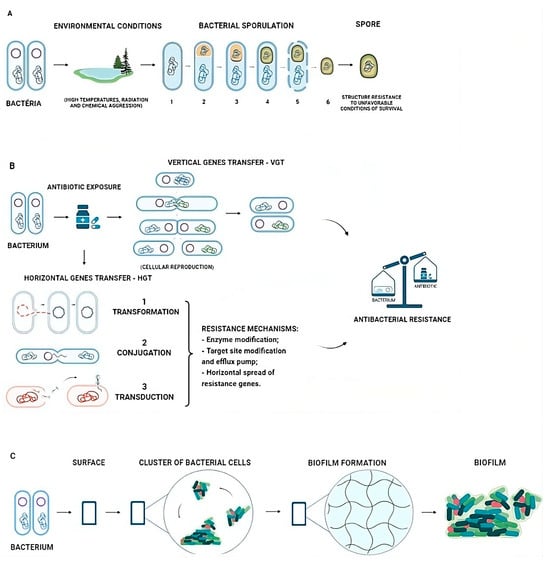
Figure 1
Open AccessReview
Immunosuppression in Sepsis: Biomarkers and Specialized Pro-Resolving Mediators
by
and
Biomedicines 2024, 12(1), 175; https://doi.org/10.3390/biomedicines12010175 - 13 Jan 2024
Abstract
Severe infection can lead to sepsis. In sepsis, the host mounts an inappropriately large inflammatory response in an attempt to clear the invading pathogen. This sustained high level of inflammation may cause tissue injury and organ failure. Later in sepsis, a paradoxical immunosuppression
[...] Read more.
Severe infection can lead to sepsis. In sepsis, the host mounts an inappropriately large inflammatory response in an attempt to clear the invading pathogen. This sustained high level of inflammation may cause tissue injury and organ failure. Later in sepsis, a paradoxical immunosuppression occurs, where the host is unable to clear the preexisting infection and is susceptible to secondary infections. A major issue with sepsis treatment is that it is difficult for physicians to ascertain which stage of sepsis the patient is in. Sepsis treatment will depend on the patient’s immune status across the spectrum of the disease, and these immune statuses are nearly polar opposites in the early and late stages of sepsis. Furthermore, there is no approved treatment that can resolve inflammation without contributing to immunosuppression within the host. Here, we review the major mechanisms of sepsis-induced immunosuppression and the biomarkers of the immunosuppressive phase of sepsis. We focused on reviewing three main mechanisms of immunosuppression in sepsis. These are lymphocyte apoptosis, monocyte/macrophage exhaustion, and increased migration of myeloid-derived suppressor cells (MDSCs). The biomarkers of septic immunosuppression that we discuss include increased MDSC production/migration and IL-10 levels, decreased lymphocyte counts and HLA-DR expression, and increased GPR18 expression. We also review the literature on the use of specialized pro-resolving mediators (SPMs) in different models of infection and/or sepsis, as these compounds have been reported to resolve inflammation without being immunosuppressive. To obtain the necessary information, we searched the PubMed database using the keywords sepsis, lymphocyte apoptosis, macrophage exhaustion, MDSCs, biomarkers, and SPMs.
Full article
(This article belongs to the Special Issue Molecular Biomarkers and More Efficient Therapies for Sepsis)
►▼
Show Figures
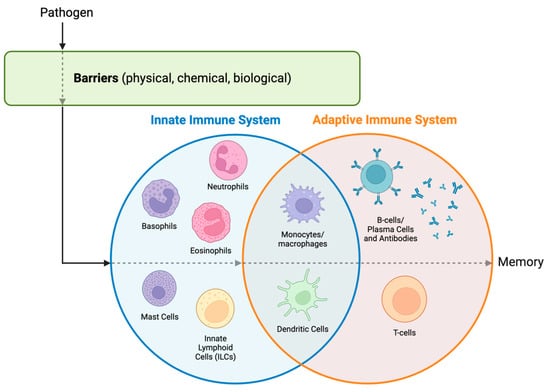
Figure 1
Open AccessEditorial
Inherited Metabolic Disorders: From Bench to Bedside
by
and
Biomedicines 2024, 12(1), 174; https://doi.org/10.3390/biomedicines12010174 - 12 Jan 2024
Abstract
Inherited metabolic disorders (IMDs), commonly referred to as inborn errors of metabolism, represent a spectrum of disorders with a defined (or presumed) primary genetic cause which disrupts the normal metabolism of essential molecules in the body [...]
Full article
(This article belongs to the Special Issue Inherited Metabolic Disorders: From Bench to Bedside)
Open AccessReview
Obesity and Insulin Resistance in Asthma Pathogenesis and Clinical Outcomes
Biomedicines 2024, 12(1), 173; https://doi.org/10.3390/biomedicines12010173 - 12 Jan 2024
Abstract
Common inflammatory ground links obesity, insulin resistance, and asthma. As recognition of their interplay, one worsening the natural course of the other, is recognised, questions remain about how to adequately address them altogether to improve clinical outcomes. The present manuscript sheds light on
[...] Read more.
Common inflammatory ground links obesity, insulin resistance, and asthma. As recognition of their interplay, one worsening the natural course of the other, is recognised, questions remain about how to adequately address them altogether to improve clinical outcomes. The present manuscript sheds light on the problem, describing possible pathophysiological links, clinical views, and therapeutic challenges, raising questions about what remains to be done, and calling for multidisciplinary treatment of these patients to detect diseases early and adequately address them before they become full-blown and deteriorate their health and quality of life.
Full article
(This article belongs to the Special Issue Pathogenesis and Novel Therapeutics in Asthma Volume II)
►▼
Show Figures

Figure 1
Open AccessReview
PET/MRI and Novel Targets for Breast Cancer
by
, , , , , , and
Biomedicines 2024, 12(1), 172; https://doi.org/10.3390/biomedicines12010172 - 12 Jan 2024
Abstract
Breast cancer, with its global prevalence and impact on women’s health, necessitates effective early detection and accurate staging for optimal patient outcomes. Traditional imaging modalities such as mammography, ultrasound, and dynamic contrast-enhanced magnetic resonance imaging (MRI) play crucial roles in local-regional assessment, while
[...] Read more.
Breast cancer, with its global prevalence and impact on women’s health, necessitates effective early detection and accurate staging for optimal patient outcomes. Traditional imaging modalities such as mammography, ultrasound, and dynamic contrast-enhanced magnetic resonance imaging (MRI) play crucial roles in local-regional assessment, while bone scintigraphy and 18F-fluorodeoxyglucose positron emission tomography/computed tomography (18F-FDG PET/CT) aid in evaluating distant metastasis. Despite the proven utility of 18F-FDG PET/CT in various cancers, its limitations in breast cancer, such as high false-negative rates for small and low-grade tumors, have driven exploration into novel targets for PET radiotracers, including estrogen receptor, human epidermal growth factor receptor-2, fibroblast activation protein, and hypoxia. The advent of PET/MRI, which combines metabolic PET information with high anatomical detail from MRI, has emerged as a promising tool for breast cancer diagnosis, staging, treatment response assessment, and restaging. Technical advancements including the integration of PET and MRI, considerations in patient preparation, and optimized imaging protocols contribute to the success of dedicated breast and whole-body PET/MRI. This comprehensive review offers the current technical aspects and clinical applications of PET/MRI for breast cancer. Additionally, novel targets in breast cancer for PET radiotracers beyond glucose metabolism are explored.
Full article
(This article belongs to the Special Issue Breast Cancer: Novel Biomarkers for Diagnosis and Therapy)
►▼
Show Figures
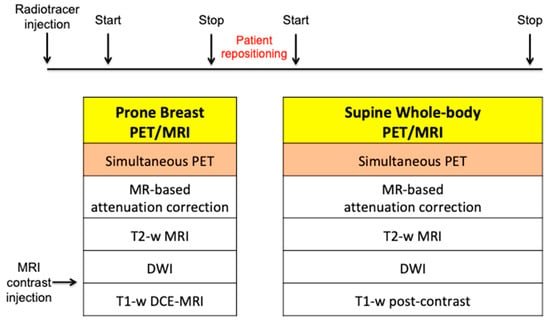
Figure 1

Journal Menu
► ▼ Journal Menu-
- Biomedicines Home
- Aims & Scope
- Editorial Board
- Reviewer Board
- Topical Advisory Panel
- Instructions for Authors
- Special Issues
- Topics
- Sections & Collections
- Article Processing Charge
- Indexing & Archiving
- Editor’s Choice Articles
- Most Cited & Viewed
- Journal Statistics
- Journal History
- Journal Awards
- Society Collaborations
- Conferences
- Editorial Office
Journal Browser
► ▼ Journal BrowserHighly Accessed Articles
Latest Books
E-Mail Alert
News
Topics
Topic in
Biomedicines, Biomolecules, CIMB, IJMS, Pharmaceuticals
Neuroprotection by Drugs, Nutraceuticals and Physical Activity, 2nd Volume
Topic Editors: Cristina Angeloni, Andrea TarozziDeadline: 31 January 2024
Topic in
Biomedicines, Cancers, JCM, Nanomaterials, Pharmaceutics
Application of Nanomaterials and Nanobiotechnology in Cancer
Topic Editors: Ayan Kumar Barui, Susheel Kumar NethiDeadline: 31 March 2024
Topic in
Biomedicines, BioMedInformatics, Cancers, JCM, Cells, Current Oncology
Cancer Immunity and Immunotherapy: Early Detection, Diagnosis, Systemic Treatments, Novel Biomarkers, and Resistance Mechanisms
Topic Editors: Tao Jiang, Yongchang ZhangDeadline: 20 April 2024
Topic in
Biomedicines, Cancers, JFB, Nanomaterials, Polymers
Advanced Functional Materials for Regenerative Medicine
Topic Editors: Antonino Morabito, Luca ValentiniDeadline: 6 June 2024

Conferences
Special Issues
Special Issue in
Biomedicines
Molecular Mechanisms of Steroid Hormone Action
Guest Editor: Omar CauliDeadline: 31 January 2024
Special Issue in
Biomedicines
Advances in Molecular Mechanisms of Head and Neck Cancers
Guest Editors: Chih-Yen Chien, Pei-Jen LouDeadline: 15 February 2024
Special Issue in
Biomedicines
Emerging Issues in COVID and T Cells
Guest Editor: Emilia JaskułaDeadline: 29 February 2024
Special Issue in
Biomedicines
Role of NO in Disease: Good, Bad or Ugly
Guest Editors: Mats B. Eriksson, Anders O. LarssonDeadline: 15 March 2024
Topical Collections
Topical Collection in
Biomedicines
OMICs and Complex Diseases
Collection Editors: Mostafa Dianatinasab, Anke Wesselius, Amin Salehi-Abargouei
Topical Collection in
Biomedicines
Feature Papers in Cancer Biology and Therapeutics
Collection Editor: Veronique Baud
Topical Collection in
Biomedicines
Feature Papers in Gene and Cell Therapy
Collection Editor: Bernard Lebleu
Topical Collection in
Biomedicines
Feature Papers in Microbiology in Human Health and Disease
Collection Editor: Ryota Niikura

















